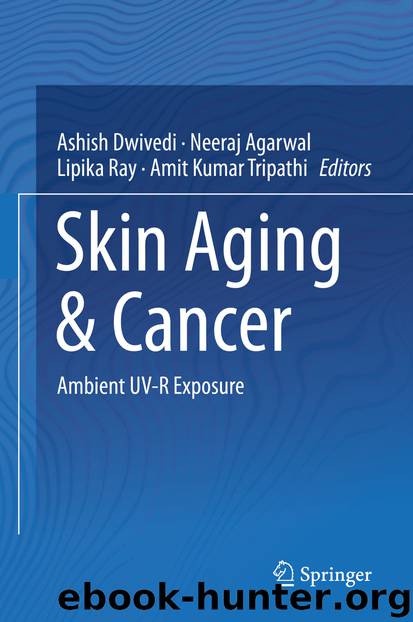Skin Aging & Cancer by Ashish Dwivedi & Neeraj Agarwal & Lipika Ray & Amit Kumar Tripathi

Author:Ashish Dwivedi & Neeraj Agarwal & Lipika Ray & Amit Kumar Tripathi
Language: eng
Format: epub
ISBN: 9789811325410
Publisher: Springer Singapore
2.4 Role of Pigmentation in Cancer
Skin pigment melanin absorbs sunlight and protects against sunlight-induced burns, DNA damage, and skin cancer. Melanin has an unusually broad absorption spectrum and perhaps also has radical scavenging activity (Kollias et al. 1991). Yet there are discrepancies in literature about the protective role of melanin. Blondes and redheads with higher ratio of yellow pheomelanin compared to brown eumelanin in skin and hairs have twofold to fourfold greater risk of melanoma than dark-haired individuals (Williams et al. 2011). Mice lacking melanin do not form melanoma after UV-A irradiation (Noonan et al. 2012), and Braf mutant mice with pheomelanin-associated Mc1re/e allele develop ten times more spontaneous melanomas (Mitra et al. 2012). UV-sensitized melanin, especially pheomelanin, triggers apoptosis and production of reactive oxygen species (ROS) and DNA strand breaks (Chedekel et al. 1978; Takeuchi et al. 2004). Melanin synthesis itself generates ROS, especially pheomelanin synthesis (Munoz-Munoz et al. 2009). Melanin-induced ROS generation is not solely responsible for melanoma development. Majority of mutations in human melanomas have the UV signature of C>T substitutions at sites of adjacent pyrimidines (Brash 2015; Krauthammer et al. 2012). Such mutations occur from the formation of cyclobutane pyrimidine dimers (CPDs) by joining of adjacent pyrimidines to distort the DNA helix (Brash et al. 1987; Schreier et al. 2007). Genetic disorders of CPD repair, such as in xeroderma pigmentosum, increase the risk for childhood melanoma by four orders of magnitude.
Premi et al. (2015) have experimentally shown that melanin can be carcinogenic to cells. UV radiation exposure of melanin-containing cells causes induction of superoxide and nitric oxide, causing a factor of ~400 peroxynitrite spike that degrades melanin. Even hours after initial UV exposure, excited melanin derivatives exist in a triplet state with high energy of UV photon. These excited derivatives go to the nucleus and transfer their energy to DNA causing mutagenic cyclobutene pyrimidine dimes in the dark ultimately leading to cancer-causing mutations.
Download
This site does not store any files on its server. We only index and link to content provided by other sites. Please contact the content providers to delete copyright contents if any and email us, we'll remove relevant links or contents immediately.
| Cell Biology | Developmental Biology |
| Entomology | Marine Biology |
| Microbiology | Molecular Biology |
| Biostatistics |
Sapiens: A Brief History of Humankind by Yuval Noah Harari(14252)
The Tidewater Tales by John Barth(12608)
Mastermind: How to Think Like Sherlock Holmes by Maria Konnikova(7227)
Do No Harm Stories of Life, Death and Brain Surgery by Henry Marsh(6891)
The Thirst by Nesbo Jo(6826)
Why We Sleep: Unlocking the Power of Sleep and Dreams by Matthew Walker(6618)
Life 3.0: Being Human in the Age of Artificial Intelligence by Tegmark Max(5474)
Sapiens by Yuval Noah Harari(5294)
The Longevity Diet by Valter Longo(5019)
The Body: A Guide for Occupants by Bill Bryson(4974)
The Rules Do Not Apply by Ariel Levy(4861)
The Immortal Life of Henrietta Lacks by Rebecca Skloot(4525)
Animal Frequency by Melissa Alvarez(4395)
Why We Sleep by Matthew Walker(4360)
The Hacking of the American Mind by Robert H. Lustig(4318)
Yoga Anatomy by Kaminoff Leslie(4306)
All Creatures Great and Small by James Herriot(4232)
Double Down (Diary of a Wimpy Kid Book 11) by Jeff Kinney(4207)
Barron's AP Biology by Goldberg M.S. Deborah T(4097)
